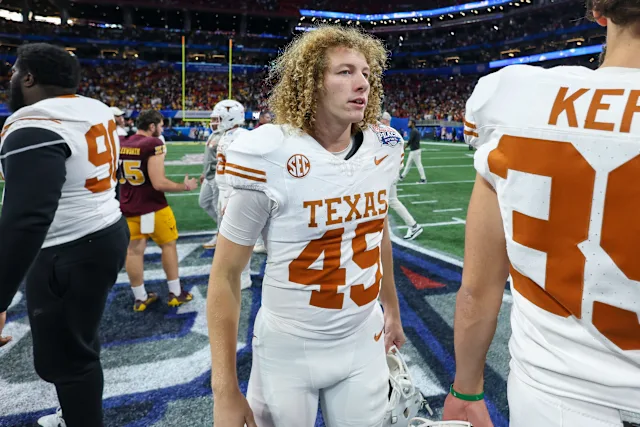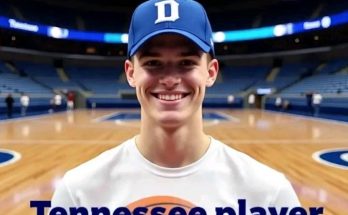The University of Texas football program was rocked Monday by significant transfer portal news that could reshape the team’s immediate future and send shockwaves throughout the Big 12 and beyond. The Longhorns, a team already dealing with intense scrutiny ahead of their transition to the SEC, now face even more uncertainty following the announcement that several key players have entered the portal. While the college football landscape continues to evolve under the weight of NIL, conference realignment, and the ever-growing influence of the transfer portal, the news that emerged Monday may end up defining the trajectory of Texas football in 2025.
The most notable departure came from wide receiver Johntay Cook II, a former five-star recruit and one of the most electrifying talents on the roster. Cook, who was widely seen as a future No. 1 option for quarterback Arch Manning or Maalik Murphy, entered the portal citing a desire for a more consistent offensive role and dissatisfaction with his usage during spring practices. In a statement released on social media, Cook thanked the Texas coaching staff and fans but made it clear he believed his potential was being underutilized in Steve Sarkisian’s current scheme. This decision sent immediate ripples across college football circles, especially given that Cook was not only one of the most talented players in Austin but also a symbol of the Longhorns’ recruiting prowess during their push to return to national prominence.
Cook’s departure wasn’t the only loss. A total of five Texas players entered the transfer portal Monday, including redshirt junior linebacker Morice Blackwell Jr., backup cornerback Austin Jordan, former blue-chip offensive lineman Payton Kirkland, and promising young tight end Juan Davis. While not all of these names were locked-in starters, the sheer volume of exits in one day suggests a larger trend: some players are growing restless with their roles, and others may be seeking bigger NIL payouts elsewhere. For a program with Texas’ resources and reputation, these developments aren’t necessarily fatal—but they are troubling.
From the outside, it’s tempting to view these exits as isolated events, just a part of doing business in modern college football. But internally, Texas has to confront whether this reflects a deeper dissatisfaction with the program’s current direction. The timing could not be worse. Texas is coming off a College Football Playoff semifinal appearance and had seemed to finally turn the corner under Sarkisian. Arch Manning, heir to one of football’s most prestigious dynasties, is being groomed as the face of the future. The defense, anchored by returning stars like Ethan Burke and Anthony Hill Jr., was expected to be one of the most physical in the country. Yet on Monday, that optimism was partially overshadowed by the sense that Texas isn’t as stable as it seemed.
For Cook specifically, the decision likely stems from a combination of factors. While he flashed game-breaking potential in 2024 with 31 catches for 462 yards and four touchdowns, he often found himself rotating with older receivers like Adonai Mitchell and Xavier Worthy, both of whom are now gone to the NFL. With the room opening up, many expected Cook to be the focal point this year. Instead, he saw redshirt freshman DeAndre Moore and transfer Isaiah Bond from Alabama taking first-team reps during the spring. Whether that was a motivational tactic by Sarkisian or a genuine depth chart decision, it clearly didn’t sit well with Cook.
Sources close to the program suggest that NIL played a secondary role in his decision. There’s growing belief that multiple SEC programs, including Georgia and LSU, are already in contact through intermediaries. NIL collectives across the country have learned how to dance around the edges of NCAA guidelines, and for players of Cook’s caliber, the offers often exceed seven figures. While Texas has one of the most powerful NIL infrastructures in the nation, with collectives like the Clark Field Collective and the Texas One Fund funneling millions into athlete compensation, the perception that Cook could earn more and be featured more prominently elsewhere proved too tempting.
On the defensive side, Blackwell’s exit is also significant. A former four-star recruit, he struggled with injuries early in his career but became a versatile contributor at linebacker and on special teams in 2024. His leadership and experience will be missed in a room that already lost David Gbenda to graduation. While Anthony Hill and other younger players are ready to step into larger roles, Blackwell’s presence gave the defense a level of depth and maturity that can’t be easily replaced.
As for the others—Kirkland, Jordan, and Davis—their departures reinforce the competitive and, at times, cutthroat nature of elite programs. Kirkland, once projected as a future starter on the offensive line, saw his development stall behind more seasoned players and incoming transfers. Jordan, a steady if unspectacular corner, never quite broke into the starting lineup. Davis, meanwhile, was buried on the tight end depth chart behind Ja’Tavion Sanders and Gunner Helm. None of these exits are individually devastating, but collectively, they strip away layers of depth that are crucial for making a deep postseason run.
The broader question facing Sarkisian and his staff now is how to respond. The timing of these entries gives Texas limited flexibility, as the spring portal window closes soon, and top-tier replacements may already be spoken for. There’s also the question of morale—how will remaining players process the exodus, particularly when it involves a high-profile name like Cook? Leadership within the locker room will be critical. Quarterbacks Manning and Murphy must show that they are not just talented, but capable of galvanizing a team that just saw several peers walk out the door.
From a recruiting standpoint, Monday’s news puts pressure on Texas to secure late additions from the portal or double down on high school recruiting. The 2025 class is strong, headlined by offensive tackle Michael Fasusi and quarterback KJ Lacey, but immediate help is likely to come via transfers. Texas has been in contact with several portal receivers, including Oregon State’s Silas Bolden and Florida’s Eugene Wilson III. Whether those efforts accelerate now is a storyline to watch over the next few weeks.
There’s also the optics factor. As Texas prepares to enter the SEC this fall, every move is under the microscope. The league’s intensity, both on and off the field, is a different beast than what the Longhorns faced in the Big 12. Losing key contributors at this stage of the offseason could be seen as a sign that Texas isn’t quite ready for the grind of the SEC. Critics of Sarkisian, long skeptical of his ability to win consistently at the highest level, are already pointing to Monday’s developments as proof of deeper dysfunction.
And yet, Texas still has an elite quarterback room, a battle-tested offensive line, and a top-five defense in terms of talent. Even without Johntay Cook, the receiving corps boasts Isaiah Bond, DeAndre Moore, Jordan Whittington, and highly touted freshman Ryan Wingo. Ja’Tavion Sanders returns at tight end, and the running back tandem of Cedric Baxter Jr. and Jaydon Blue is arguably one of the best in the country. This is not a team in disarray. But it is a team facing pressure and navigating the new world of college football where rosters can change overnight.
Sarkisian addressed the transfer news in a brief statement Monday evening, acknowledging the challenges of the portal era while expressing confidence in the program’s foundation. “We wish those guys nothing but the best,” he said. “Every player has to make the best decision for their future. We believe in the team we’re building and the direction we’re headed.” That may be true, but in a program where expectations have outpaced results for over a decade, the margin for error continues to shrink.
The departure of someone like Cook may also be a signal to boosters and collective organizers that Texas cannot rely solely on branding and history to retain elite talent. In an NIL-driven landscape, constant engagement and financial competitiveness are no longer optional—they are foundational to survival. Alabama, Georgia, and even Miami have demonstrated that being aggressive in the portal is essential, and schools that don’t adapt will find themselves outpaced quickly.
Looking forward, Texas fans will be watching closely to see how the team rebounds from this turbulence. The summer workout period begins soon, and fall camp will bring clarity on positional battles. All eyes will be on how Arch Manning commands the offense, whether Bond and Moore can replace Cook’s production, and how the defense holds up against a gauntlet SEC schedule that includes Alabama, Texas A&M, Georgia, and Florida.
What happened Monday may not determine the Longhorns’ season, but it’s a reminder that the margin between national contender and underachiever is razor-thin in modern college football. The road to greatness is never smooth, and Texas now finds itself needing to prove, once again, that it belongs among the sport’s elite—not just in terms of hype, but in depth, stability, and championship-level execution.
Whether this is a temporary setback or a harbinger of deeper issues remains to be seen. What’s certain is that Monday’s transfer portal news was more than a roster update—it was a test of Texas’ adaptability, leadership, and long-term vision as the Longhorns prepare to enter the most competitive environment in college sports.



